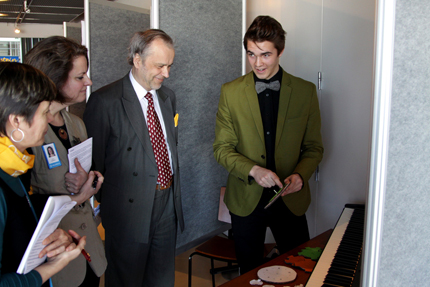Music theory innovation and research on four-colour problem will represent Finnish talent at EUCYS 2013
Last week, the final of Finnish Contest for Young Scientists was held at Heureka Science Centre. In the category for high school students and under 21-year-olds two projects rose above the others and will represent Finland at EUCYS 2013 in Prague.

Perttu Pölönen introducing his innovation to the jury of Finnish Contest for Young Scientists. Photo: Sakari Tolppanen.
The idea for Tutki-Kokeile-Kehitä (Finnish Contest for Young Scientists) winner Perttu Pölönen’s innovation started to form gradually two years ago when he was playing with the thought that there are the same amount of numbers in a clock as there are pitches in octave.
Perttu, who is currently a second-year student at Vaskivuoren lukio, high school that specialises in music, started to develop this idea and eventually came up with a tangible innovation to be used in music pedagogy.
The design that Perttu introduced to the jury of Tutki–Kokeile–Kehitä is a simple but practical device for teaching musical theory for people of all ages. The innovation is unique and patent for it is pending.
Perttu says that the device is now being developed further to a commercial product that could be used in schools and institutes where music theory is taught. One day it might even reach international markets.
The jury for Tutki-Kokeile-Kehitä praised Perttu’s innovation for being something totally novel. After the prize ceremony, Perttu said that secret behind successful innovation is that if you are interested in solving a certain problem or improving an existing product, you shouldn’t be too self-critical, but try several approaches and by doing that you may end up creating something unique.
Perttu studies at Sibelius Academy’s Junior Academy and plans on continuing his studies of composition or conducting after high school. He is also looking forward to participating in European Union Contest for Young Scientists (EUCYS).
EUCYS 2103 will be held in Prague in September. As the first prize of Tutki–Kokeile–Kehitä was shared between two works, also Eero Räty and Samuli Thomasson from mathematics specialized high school, Päivölän kansanopisto will be presenting their research during the contest.

Eero Räty and Samuli Thomasson after the prize ceremony. Photo: Sakari Tolppanen.
Their research is about finding colouring combinations to solve four-colour problem in maps using graphs.
Eero says he studied four-color problem last summer, and found that determining different colour combinations was a subject that hadn’t been studied much before. Eero asked Samuli to join him in the project as programming needed in the process is something he enjoys doing.
During the process, they studied the influence of different characteristics of maps on the possible colour combinations when four colours can be used and areas next to each other have to be coloured in different colours.
According to Eero, the best part of the research process was when the designed models worked after moments of doubt. Tutki–Kokeile–Kehitä jury said that the achievement is university-level, and Eero and Samuli show excellent skills in mathematics and modelling, and open new horizons into traditional mathematics.
Eero says that doing research is a good idea even before university. It is a good lesson on how to plan and conduct research projects later. Eero has applied to study mathematics at Cambridge University. Samuli plans on studying Computer Science in Helsinki after high school.
Video from Tutki–Kokeile–Kehitä finals. The contest is for 6 to 20 year-olds, who compete in three age categories.
 Elisa Lautala works as web editor for University of Helsinki's Faculty of Science. Elisa likes all kinds of cultural events, good books, warm weather, and aqua-jogging.
Elisa Lautala works as web editor for University of Helsinki's Faculty of Science. Elisa likes all kinds of cultural events, good books, warm weather, and aqua-jogging.